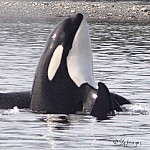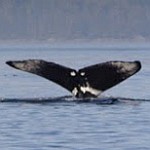Harbour Porpoise
Harbour porpoise mainly travel in small groups of 4 to 10 individuals. In these groups, mother and calf pairs are often present. Harbour porpoise have been observed to travel individually. On occasion, they have also been observed to be in larger aggregations of about 50 animals.
Dall’s Porpoise
Dall’s porpoise travel in small groups, usually numbering less than 10 individuals. Larger aggregations of Dall’s porpoise have been observed occasionally, with hundreds of porpoise concentrated in a location to catch prey. They have been know to cross breed with the Harbour porpoise producing hybrids.
Pacific White-Sided Dolphin
Pacific White-Sided dolphins travel in groups as small as 3 to 6 individuals and frequently as large as a few hundred. Even larger groups of thousands have been observed on occasion. However, the majority of groups of Pacific White-Sided dolphins are less than one hundred, and contain a mix of males, females, and juveniles. They are highly social and are often seen traveling with other species of dolphins and larger whales.
Minke Whale
Minke whales are mainly solitary animals. Occasionally, they may pair up or form a group of three. Larger groups may form for short periods of time in feeding and mating areas.
Gray Whale (Grey Whale)
Gray whales may travel alone or they may form groups of various sizes ranging from 3 up to 16. Cow-calf pairs are often seen and their bond is strong. Mothers defend their young aggressively, which earned them the name “devilfish” from whalers who hunted them. Males rarely travel with cow-calf pairs.
Humpback Whale
Humpback whales may be solitary or may travel in small groups of 3 to 4 individuals. Occasionally, groups of 10 to 12 animals do form. Larger groups may form for short periods of time in feeding areas.
Orca – Resident Killer Whales
Resident Orca travel in pods that consist of a matriarch and her offspring. Each pod may consist up to 10-12 animals and is characterized by a distinct vocal dialect. A clan is a grouping of several pods that derived from a common ancestor and the pods within a clan have similar dialects. Clans may form resulting in much larger groups. The Northern Resident Orca and the Southern Resident Orca do not inter-breed.
Orca – Transient Biggs Killer Whales
Transient Biggs Orca travel in small pods consisting of 3-6 animals and each pod contains a matriarch and her offspring. It is rare for a number of pods to join and form superpods. Transient Biggs Orca appear to use the similar vocalizations with some variations depending on location and/or pod. Individual Orca, usually females but sometimes males, leave their pod and travel with other Transient Biggs pods to mate.


